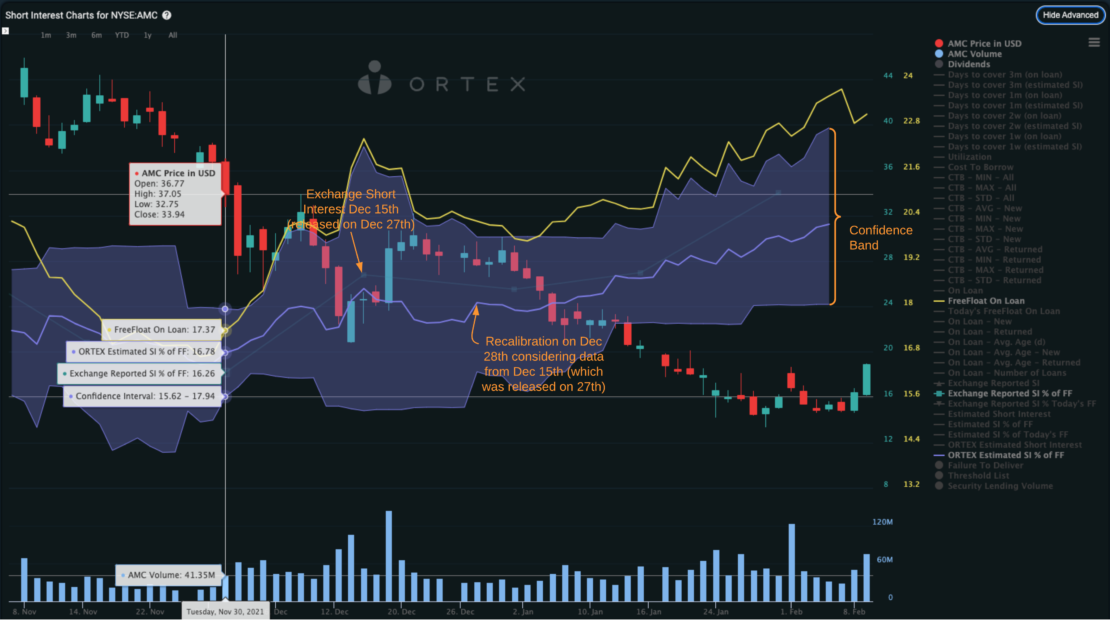Changing the way ORTEX presents Short Interest Estimates
From Monday February 14th, 2022, ORTEX is changing the methodology it uses to calculate Estimated Short Interest. This article explains the background to this change and to short interest estimation.
Why does ORTEX have an estimate of Short Interest and not just publish the actual short interest?
The truly real-time Short Interest data for a stock isn’t available in any market. In US markets, FINRA regulation 4560 ensures that exchanges publish short interest positions, so there is a basis to understand the Short Interest. The record of total short positions has to be passed to FINRA from brokers, for customer and their own accounts and there are potentially severe legal penalties for non-compliance. Currently, this data is only published twice a month, and the data is delayed by 7 trading days, and this lack of up-to-date Short Interest data disadvantages the investor.
In order for a stock to be sold short, short sellers have a legal obligation to borrow shares to settle the trade so, by tracking securities lending data in real-time, it is possible to estimate short interest to fill the gap in the official data. Ortex has been providing short interest estimates for several years, but we are now changing the methodology of how we do this.
What is this new estimation methodology?
Our new model is a machine learning model that is constantly learning and adjusting as new data is released. It works on a stock-by-stock basis and estimates a range of likely levels, given the current state of the market. Our new methodology also considers more factors than the previous methodology, and also has a higher regard for historical lending/short interest patterns for each stock, in order to improve the reliability of the estimates for all stocks. Our backtesting shows significant improvements over the current estimation model. With this new model, we are also introducing the confidence limits for our estimates.
Why confidence limits and what do they mean?
If stock lending is relatively static or increasing smoothly, we can be generally confident that the number of shares On Loan and the estimated Short Interest will likely be moving in similar timescales but there is a degree of lag between stock lending and Short Interest because of settlement.
Our Stock Lending data is up-to-date data, and is updated throughout the day as stock lending takes place, but there can be a lag in either direction as, for example, it is permitted for a short seller to sell short having located (i.e., arranged to borrow) shares, but they do not have to borrow them until the settlement day, 2 days later. Conversely, a borrower may borrow shares with the intention of shorting, and then delay the short sale.
The exchange reports short sales that have “settled or reached settlement date by the close of the reporting settlement date” (FINRA regulation 4560). This means that even trades that Fail to Deliver will be included in these figures. However, as we only see a point in time our estimates may be correct for the day before, or after the exchange reported days as large trades settle, but we can not know that. Confidence limits allow us to express this range of values more effectively and also highlight that significant changes in stock lending, for example, will reduce the confidence in our estimates until we get more data. The width of the confidence limits reflects the reliability of the estimate for that stock on that day.

New ORTEX Estimated Short Interest example for AMC
Above is an example of how this works. Just prior to Dec 15th, there was a marked increase in Shares On Loan. The speed of this increase also increases the prediction uncertainty and, as such, the width of the confidence interval also increases. On Dec 27th, we receive the data from NYSE which confirms the volume of all short interest trades that have settled prior to Dec 15th. As there is a slight gap between the estimate and the reported value, the estimate is calibrated upwards slightly. As we now have data that is only more recent, and as Shares On Loan have dropped, the width of the confidence band decreases, as we are more certain about the estimate at that point.
How is this estimation methodology going to be published?
We are very conscious of the fact that the new estimate will be replacing historic estimates with revised estimates using the new methodology and that changes to past data are sensitive.
On Monday Feb 14th 2022, the new methodology has replaced the existing one on the Short Interest chart. Whereas the former is still called Estimated Short Interest and Estimated SI % of FF, the new algorithm is called ORTEX Estimated Short Interest and ORTEX Estimated SI % of FF.
Now the new estimation methodology has been published, this has resulted in changes for all stocks; some estimates have gone down and some have gone up. This does not mean that the actual Short Interest has changed, only the estimate.
To provide transparency and allow people to compare the new algorithm with the historic algorithm, the old estimation method has moved to the Advanced chart (accessible by clicking Show Advanced in the top right corner of the chart). The old data will continue to be shown for at least one month before it is retired and removed from the system.
Anyone with queries is welcome to direct them to support@ortex.com